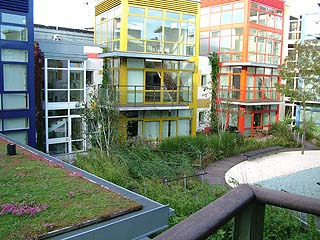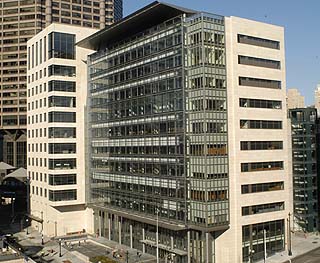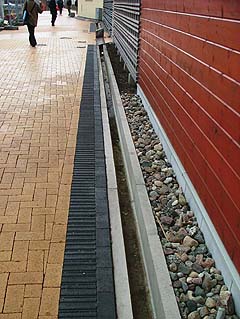|
Subscribe / Renew |
|
|
Contact Us |
|
| ► Subscribe to our Free Weekly Newsletter | |
| home | Welcome, sign in or click here to subscribe. | login |
Architecture & Engineering
| |

|
|
Design Perspectives By Clair Enlow |
February 23, 2005
Design Perspectives: Is Seattle in danger of losing its LEED?
Special to the Journal
This month in his annual State of the City address, Mayor Greg Nickels took the environmental high ground, pledging to honor the 1998 Kyoto treaty for climate protection, despite lack of support from the federal government.
"Seattle, along with other U.S. cities, will provide the leadership necessary to meet this (global warming) threat," said Nickels.
But while the mayor continues to champion smart growth, hard-won gains in sustainable building could be lost.

Photo courtesy of International Sustainable Solutions
In Malmo, Sweden, this housing complex filters stormwater through green roofs and specialized landscapes.
|
House Bill 1272, sponsored by Rep. Hans Dunshee, D-Snohomish, is making its way to the House and Senate in Olympia. As currently drafted, the law would require all state buildings over 5,000 square feet, including schools, to meet standards for certification under LEED, the U.S. Green Building Council's Leadership in Energy and Environmental Design.
This is precisely the standard set by city policy five years ago. Seattle City Council members Peter Steinbrueck and Richard Conlin have made their support for the bill clear, traveling to Olympia last week to lobby for it.
Yet support from the mayor and his staff is weak.
"We support the goals of the legislation," said Steve Nicholas, who speaks for the administration as head of the Office of Sustainability and Environment, "but it needs to supply some flexibility for developers."
According to Dorothy Mackenzie, author of "Green Design: Design for the Environment," the by-products of the built environment are responsible for more than half of the greenhouse gases that fuel global warming.
It doesn't take a lot of expertise or imagination to see that the countless decisions that go into site planning, building re-use, heating and cooling, and construction materials have a lot to do with the environment.
Forests decimated, jet fuel consumed, rising demand for power: these worldwide environmental costs don't show up on the developer's balance sheet. In economic terms, they're called externalities, and reducing them benefits us all.
Interior air quality gains are largely the result of natural ventilation and a dramatic reduction in the volatile organic compounds found in materials and finishes. A 1999 study by the Heschong Mahone Group of Sacramento, Calif., found an increase of up to 26 percent in learning rates in three school districts, including Seattle's, when natural light was added to the learning environment.
The extra cost of building to LEED standards on the first seven city of Seattle projects ranged from zero to 6 percent — depending on the building size and type, the LEED level being sought, the dedication of the design team, and who you talk to. Most agree that much of the cost is recouped in the first several years through energy savings and lower water use.
Changing our minds

Photo courtesy of CDi Engineers
The Seattle Justice Center is one of seven projects to be LEED certified. In its double-glazed thermal buffer wall cools the building during the summer, and helps keep it warm in the winter.
|
Tony Gale, principal designer and chair of Fulton Gale Architects, was the city architect for Seattle for five years before leaving last spring, when his position was cut by the mayor's office. A key advocate for LEED, he worked with design teams to bring several projects — including the Justice Center and new City Hall — to LEED silver standards and better.
Improving air quality is fundamentally simple, he said, once the old mindset is changed.
"Stay away from the hermetically sealed environment," said Gale. "Remove the chillers. Replace them with natural air conditioning and operable windows. Turn the mechanical shafts into thermal flumes. Put awnings outside of buildings."
In practice, the mayor's environmental policy has run strongly to smart growth and dense development. And it has favored education and outreach over binding legislation or code-based incentives for sustainable buildings.
Last week, I watched a panel of high-profile developers sit across from city staffers on the 40th floor of Key Tower, sharing their impressions of urban Denmark and Sweden, where green roofs, natural ventilation, biofiltering, dense development, and widespread use of bicycles and mass transit are becoming the norm. The group toured those countries this winter, joined by the Department of Planning and Development Director Diane Sugimura — the first city official to go.
"The natural balance is at a breaking point," developer Greg Smith read from a meditative text he had written about Seattle after the trip. "You have the knowledge and technology to choose a better destiny. But do you have the will and desire to change your habits and policies? Â… Slow down sprawl. Don't eliminate more forests, pollute more air and water, to expand your suburbs."
Jason Antonoff, an engineer who organized the tour, said in Denmark — which has roughly the area, population and economic output status of Washington state — there is a general expectation that the construction market will operate within pre-set parameters.
"People trust government there," said Antonoff. "They expect government to lead and to set the standards. It's a social democracy, and there is much more of a cooperative mind set."
Incentives needed
When it comes to sustainable building, education and outreach from City Hall have been a great success. The response among developers has been strong and impressive. But these downtown developers, though powerful and influential, may not speak for the larger developer community.
"If we want to see a substantial change, a revolution in the way we design buildings, we need to look at regulatory incentives as a first step," said council member Peter Steinbrueck. "It's energy, it's water, it's wastewater. It needs to go beyond promotion and education. That won't get us there, on a scale that is ecologically effective."
Steinbrueck would like to see new incentives for developers, trade-offs that would grant more height and design freedom in return for investments in green building or infrastructure.
"Density is a value-neutral term," he said. "I'm against destructive density."
"If we are going to adjust our zoning to get taller buildings, are we getting what we want?" he added. "We could say that the office core is not achieving that."
Council member Richard Conlin came into office in 1997 running on an environmental agenda. Soon after, he organized a regional consortium for Green Buildings. The plan that resulted included economic forecasting, educational workshops and outreach to homeowners and developers — including a study of the impacts on low income housing.
On Earth Day in 2000, the City Council passed a resolution directing City Light to create a strategy to reduce greenhouse gas emissions and invest in green power production.
And then in 2001, the council formalized a commitment to honor the Kyoto agreement. Last year, the council commissioned an audit to determine what has been done and suggest what the impacts are likely to be. The report card was good, according to Conlin. "We've done a lot. But the risks (to the environment) are still great."
A goal, not a law

Photo courtesy of International Sustainable Solutions
An open channel at the base of the wall collects rainwater, an above-ground solution that keeps stormwater clean and reusable. Such sustainable building methods in Malmo, Sweden, are becoming commonplace in Scandinavia, thanks in part to broad public support.
|
But the message from the mayor and the staff members who speak for him is clear: sustainable design and construction is a goal. And so is LEED certification. A goal — not a promise, and not the law.
Sustainability is not just about goals, or political capital. It's hard to imagine making a dent in that 50 percent greenhouse gas increase without across-the-board standards. We must keep the city moving toward the day when it's an easy leap to hold all medium-to-large construction and renovation projects accountable.
And when that day comes, the holdouts who claim these standards are a profit-killing burden will at least have the consolation of knowing that the playing field — at least in this jurisdiction — is level.
In the meantime, industries that support construction can begin to plan — with some certainty — to refocus on sustainability.
The city's hard-won achievements of the last few years are solid concrete-and-steel examples.
If city buildings meet sustainable standards only as the budget allows, those gains will erode. And if, as a design client, the city is not committed up front to rigorous sustainability standards, it will fail.
If the city can't do it, how can the state?
It may not be time yet make LEED certification a requirement for every sizeable building — public or private. But it's probably time to confirm the city's commitment by making the policy statement of five years ago into a binding ordinance.
Years of commitment and hard work have put Seattle in the LEED. The momentum of the last five years must be maintained, not lost. To rephrase mayor Nickels' own campaign slogan, let's keep Seattle moving.
Clair Enlow can be reached by e-mail at clair@clairenlow.com.
Previous columns:
- Design Perspectives: Cities can enjoy their past and future, 02-02-2005
- Design Perspectives: Massive change and modest constructions, 12-22-2004
- Design Perspectives -- U District debate: 'What would Jesus do?', 11-24-2004
- Design Perspectives: New transparency reveals 'heroic structural efforts', 10-20-2004
- Design Perspectives: Will Vancouver transit model work in Seattle?, 09-22-2004
- Design Perspectives: South Lake Union: ever-green and growing, 08-25-2004
- Design Perspectives: BAM reborn: accommodating a new mission, 07-21-2004
- Design Perspectives: Home sweet home is a cargo container, 06-23-2004


